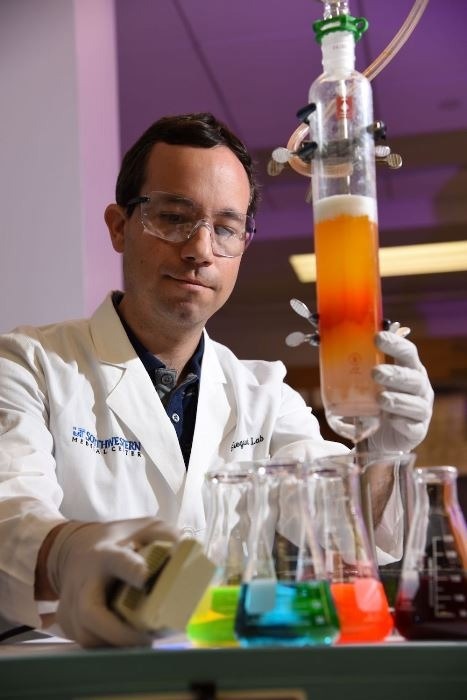Solid tumors develop a strong, impenetrable molecular defensive wall around themselves as they enlarge. Thus, it is extremely difficult to get narcotics past the roadblock.
 Daniel Siegwart, Ph.D. Image Credit: UT Southwestern Medical Center
Daniel Siegwart, Ph.D. Image Credit: UT Southwestern Medical Center
To target cancer cells, scientists at UT Southwestern have now created nanoparticles that can penetrate the physical barriers around tumors.
When the nanoparticles get inside, they release their payload, which is a gene-editing mechanism that modifies the tumor’s DNA to stop its development and stimulate the immune system.
The growth and metastasis of liver and ovarian cancers in mice were substantially halted by the novel nanoparticles, as published in Nature Nanotechnology.
According to research leader Daniel Siegwart, Ph.D., Associate Professor of Biochemistry at UT Southwestern, the system offers a fresh direction for the application of the gene-editing tool CRISPR-Cas9 in the treatment of cancer.
Although CRISPR offers a new approach for treating cancer, the technology has been severely hindered by the low efficiency of delivering payloads into tumors.
Dr. Daniel Siegwart, Associate Professor, Biochemistry, UT Southwestern Medical Center
Researchers already have a method for selectively editing the DNA within living cells owing to CRISPR-Cas9 technology. Delivering CRISPR-Cas9 to solid tumors has proven difficult, despite the gene-editing system’s ability to change the genes responsible for cancer development.
Dr. Siegwart and his colleagues have been researching and developing lipid nanoparticles (LNPs), small spheres of fatty molecules that can transport molecular payload into the human body, including the current mRNA COVID-19 vaccines. In 2020, Dr. Siegwart’s group demonstrated how the nanoparticles could be directed to specific tissues, which had been somethng that had previosuly limited the field.
The researchers started with nanoparticles that they had already modified to travel to the liver in the current work to target cancer. They included a small amount of RNA (short interfering RNA, or siRNA) that could turn off focal adhesion kinase (FAK), a gene that is essential for maintaining the structural integrity of certain cancers’ physical defenses.
Targeting FAK not only weakens the barricade around tumors and makes it easier for the nanoparticles themselves to make their way into the tumor, but also paves the way to allow immune cells in.
Di Zhang, Study First Author and Postdoctoral Research Fellow, UT Southwestern Medical Center
Researchers incorporated CRISPR-Cas9 technology that could modify the PD-L1 gene within freshly created nanoparticles. The PD-L1 protein, which inhibits the immune system’s capacity to combat tumors, is produced in abundance by many malignancies using this gene.
Scientists have previously demonstrated that, in some malignancies, altering the PD-L1 gene can remove the brakes and allow a person’s immune system to destroy the cancer cells.
Four mice models of ovarian and liver cancer were used to evaluate the novel nanoparticles by Dr. Siegwart, Dr. Zhang, and their colleagues. First, they demonstrated that by using siRNA to turn off FAK, the matrix of molecules around the tumors became less rigid and more permeable than usual.
The tumor cells were then examined, and it was discovered that several other nanoparticles had successfully altered the PD-L1 gene.
The researchers discovered that tumors in mice treated with nanoparticles that targeted both FAK and PD-L1 reduced to around one-eighth the size of tumors treated solely with empty nanoparticles. Additionally, more immune cells invaded the tumors and treated mice lived roughly twice as long on average.
Further research is needed to demonstrate the nanoparticles’ safety and usefulness in a range of tumor types. According to the researchers, the treatment might be used in tandem with known cancer immunotherapies that harness the immune system to fight tumors
Dr. Siegwart stated, “After the worldwide success of the COVID-19 LNP vaccines, we are all wondering what else LNPs can do. Here we developed new LNPs capable of delivering multiple kinds of genetic drugs simultaneously to improve therapeutic outcomes in cancer. There is clearly great potential for LNP medicines to treat different kinds of diseases.”
Dr. Siegwart is a co-founder and consultant of ReCode Therapeutics, which licenses intellectual property from UT Southwestern.
Journal Reference:
Zhang, D., et al. (2022) Enhancing CRISPR/Cas gene editing through modulating cellular mechanical properties for cancer therapy. Nature Nanotechnology. doi:10.1038/s41565-022-01122-3.
Source: https://www.utsouthwestern.edu/